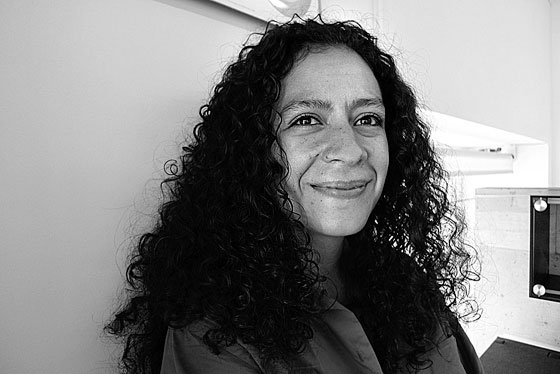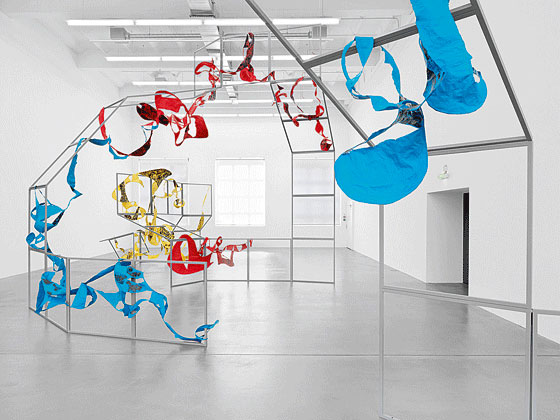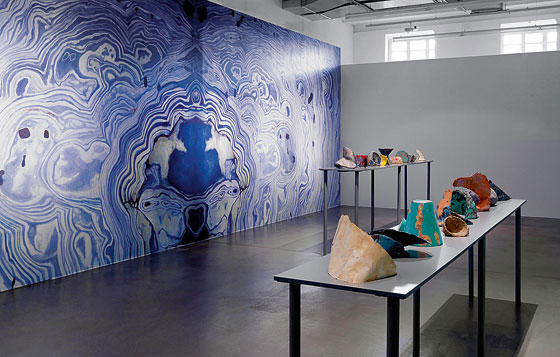|
|
| Uncomfortable confrontations and thinkable projections Barbara Fässler, Artist Mariana Castillo Deball | |
| Whoever puts their head into the show Uncomfortable Objects at Haus Konstruktiv in Zürich these days will not stop wondering. Instead of pure monochrome paintings or heavily geometric compositions, some strongly coloured organic forms twist in a uncontrolled way, like the “Magic Bean”, around a three dimensional metal grid that crosses the whole space. For many years, the artist Mariana Castillo Deball operates on the interface between Science and Art, looking for new possibilities of knowledge in the field between fiction and facts, between myth and reality. The artist, born in 1975 in Mexico, won the 2012 Zürich Art Prize of Haus Konstruktiv and Zürich Insurance, which granted her a personal show with a catalogue to the value of 80000 Swiss francs. The daughter of an opera singer and a printer, Castillo Deball studied philosophy and art in Mexico City and Maastricht, lives between Amsterdam and Berlin, and demonstrates a considerable career. There isn’t almost any biennial or important international show where she hasn’t participated: Biennial of Shanghai (2007), Athens (2009), Saõ Paolo (2010) and Venice (2011), but also Manifesta 7 (2008), and dOCUMENTA (13) in Kassel this summer. | |
 Mariana Castillo Deball. 2012 Photo: Barbara Fässler | |
| Through engrafting between scientific and artistic methods the energetic South American artist creates a new, extremely fertile reality which seems to obey its own laws, and is able to evolve in different, unpredictable directions. The classical techniques of science, that is to collect, to select and to order within categories, lead Mariana to apparently inexhaustible installations that are able to fill up whole spaces. In her transdisciplinary procedures, called by the artist “diagonal methodology”, she often meets people from various fields of science, who inspire a new direction in her research. Like an artist in a circus, Castillo Deball juggles with mixed ingredients and combines apparently opposed strands in a strangely relaxed way, in a continuous procedure which gains visibility through different forms: from installation to sculpture, from drawing to wallpainting. Almost obsessively, Mariana combs through libraries, museums and archives around the world, looking for new material. There is never only one way to knowledge, but always several of them. In our dialogue, she comments: “I always collaborate with people from different disciplines and I always have very specific questions, so I don’t think I’m just interested in the relation between science and art. It’s more that I have particular questions and in order to answer those questions, I take resources from different disciplines or from different areas of knowledge. But this is a natural result of my questions. It is not that I want to necessarily work with scientists or necessarily work with archeologists. It really depends on the moment and on the project I am working on. I work on very longlasting projects. One project can take me five years to be developed. So then I go step by step and it keeps on growing and growing…” In her delicate dancing on various levels, the Mexican investigates, for example, how poetry and research or fiction and production of knowledge are connected. She explains the background of her artwork The Where I am is Vanishing at the last Venice Biennale. This is a twelve metre long paper strip with handsome felt pen drawings, inspired by the Borgia Codex, a pre-Columbian Aztec calendar which now belongs to the Vatican Library and takes its name from its first owner, Cardinal Borgia. Mariana Castillo Deball: “In the last years, I’ve been focusing on other kinds of these “uncomfortable objects”, looking at them from different perspectives, like the one of history or the one of archeology, and what I do is, I kind of follow the history of an object and see how it has been used throughout the centuries or throughout the years. I’d like to find out how these objects can have different meanings, different functions and different spaces, where they existed. In the case of the Aztec Codex, I tried to understand how they wrote the book, the way it was almost burnt by the Spanish people, how they escaped and finally how the book arrived in Italy where nobody understood it. So it’s about how all of these items have been understood or misunderstood throughout the years. For this piece, it is the book that is telling me its own story. So this is something important in these series of works called Uncomfortable Objects: that I always try to speak from the point of view of the items where the facts are much mixed with fiction.” The newest version of Uncomfortable Objects on the ground floor of Haus Konstruktiv is also about things that are difficult to classify. A strongly geometric scaffolding, a spiral unfolded square grid, traverses the whole space and hosts a twining sculpture which contrasts heavily with the cold and angular structure of the grid. As if we should always be reminded of the contradiction between nature and culture, between intuition and rationality. The wildly arranged item is made out of organic papier-maché forms which include digital prints and fragments from pictures. To the question of what is uncomfortable in her work, Mariana Castillo Deball answers: “Well, the title of the exhibition is Uncomfortable Objects and it belongs to a series of works I have been developing since two or three years ago. It all started with a story I read by two writers, André Breton and Roger Caillois, the two surrealists and thinkers; they were once in Mexico and they found those beans, called by Mexicans “jumping beans”, because they jump on their own. So Breton and Caillois started to have a discussion, if it was magic, if it was like a miracle or if it was science. In a way these jumping beans generated the discussion between the two intellectuals and therefore they are somehow uncomfortable objects. I found a series of examples which are similar and I am interested in items that cannot be fixed into one category. You cannot look at those objects just from one direction, but they always offer more and more questions to the people who relate to them. I think there are a lot of scientific objects or scientific phenomena that change a lot and they even have different names according to the direction you approach them. I mean, if you study mountains, you will call “wind” in a different way to a meteorologist or as a biologist. So you have may the same phenomenon, but you will call it in different ways, according to the discipline.” | |
 Mariana Castillo Deball. Uncomfortable Objects Installation. Fragment. 2012 Photo: Stefan Altenburger Publicity photos Courtesy of the artist | |
| A switching point of view leads us to ambivalence of perception and interpretation. The climbing construction with its wrappings calls to mind strongly the form of DNA, indeed a genetic structure totally out of order. Does the artist focus in the end on the origins of our culture? Looking in more precise manner, more signs in this direction emerge, as for instance the three primary colours: red, yellow and blue used all over the whole installation. With those three original colours, all the others can be mixed. Another link to the topics – the research of origins in nature and culture – could be the pictures that are integrated in the ranking construction from mineralogy, archaeology and history. How does the artist regard this interpretative approach? Mariana: “Well, many people come to the idea of DNA and I think there is, indeed, some resemblance. But originally I started to experiment with these structures, with these kinds of sculptures in papier-mâché, deputing from the collection of mathematical models I’ve been working with, and also with the kind of plants which only exist in the tropics called epiphytes, like orchids or the bromeliad species. They also call them air plants, because they climb on other trees, but they are not parasites, nor is it a symbiosis. They are just hosted by those other structures. They get all their food from the air, or water, they don’t eat from the hosting structure. I was interested how these two elements could each have its own existence, but at the same time live together. In the installation on the ground floor I actually tried to play with very basic elements. So, for instance, there is this metal grid, which is a square that is unfolded into a sort of spiral, and also the colors that I used for the papier-mâché sculptures are primary colors. I took some very simple elements and then started to play with them until they got a bit more complex, and built up a space that has more charge of the different elements. The yellow is about archeology and ethnology, the red has to do with these plants I was talking about before, the epiphyte plants, and also mathematical models, and other architectonic elements that I found in Brazil, and the blue has more to do with minerals and rocks and other sort sof fantastic creatures, let’s say, like hybrid creatures.” When we go up to the first floor, we again find several items that on the ground floor have been only slightly indicated. This time they are isolated from their involuntary context in the papier-mâché snake and are engineered in a very clean manner, like in a Museum of Natural History. It looks as if the artist had made the meta-level of exhibiting itself the subject of discussion. The function of museums appears in all its ambivalence and contradictoriness: on the one hand, the objects are valorised and gain a new visibility, on the other hand, they are de-contextualized and mummified. Each museum reflects, through the selection process and exhibition-display, its own interpretation of a part of reality, and hence the point of view of the curators. The museum can’t be considered a passive container of apparently “neutral” meanings, but is an active producer of social and cultural significance. In this “museum in the museum” created by the Mexican winner of the Zürich Art Prize we find, for example, some of the mathematical models from the collection of University of Göttingen, curated and built up by the famous mathematician Felix Klein at the beginning of the 20th century. These historical pieces represent the effort and the possibility – in itself – of transcribing abstract concepts and ideas visually and in three dimensions, a basic concern of the South American artist. Castillo Deball: “Felix Klein was actually a pioneer of nonEuclidian mathematics or geometry and he constructed those models not as a part of his research, but as a didactic tool to teach students. The institute in Göttingen was designed to host these collections, so there is a permanent display of all the models, which is very interesting. Within the models he built, Klein also included Euclidian geometry: there are some cones and some figures which are just models of traditional mathematics. Only after he had visualized the familiar conception of space, Klein started to develop other kinds of surfaces. For example, he invented a Klein bottle, a sort of Moebius strip but in four dimensions, which is impossible to depict in three dimensions because you would need four dimensions, and so he made an approximation. What is interesting about these models is that they are not actually showing an equation, but they are just approximations of an idea. You cannot really represent mathematics in two dimensions, in one dimension or in any dimension. They are just models, and therefore an approximation of what it would be or what it would look like.” The impressing visual embodiments inspired Mariana to create a series of small sculptures of plaster titled Mathematic Distortions, produced in traditional stucco technique at Sitterwerk, St. Gallen. This technique, where plaster is mixed up with pigments, was used in the Baroque churches of the 17th century in order to imitate marble. The manageable sculptures seem to rise from a fictional archaeological site and are a reminder of the original motor of all sciences: by digging and interpreting to discover new knowledge. What exactly is interesting for the artist in the process of discovering and the research of truth? | |
 Mariana Castillo Deball. There are no spaces in words as people speak them. Painting on the wall. In the foreground: Mathematical distortion. Objects. 2012 Photo: Stefan Altenburger Publicity photos Courtesy of the artist | |
| Mariana Castillo Deball: “As you know, I am from Mexico and I made a lot of works related to Mexican archeology which are, in a way, more related to historical rather than archeological facts. In the case of this exhibition it has nothing to do with Mexican archeology, but it has to do with what you were talking about: how you find an image and how you create a picture, somehow. So I often use a term “potential images”, which are images that are not made by humans, but ones that you construct through perception. So, for example, in this mural painting. I visited a lot of caves in different parts in Brazil and there are sometimes guides who take you through those caves and they tell you, well here is the face of Jesus, or a piece of bacon, and you need to find these images in a place where there are actually no images. So one of the main points in this exhibition is the idea of projection. You should ask yourself how much you find things, or how much you project what you already wanted to find. The question is how you can come away from those expectations and how you realize in which way you already have a set of knowledge and a set of ideas that you project into the world. So we see what we want to see, there is no “neutral” relationship with the outside”. The huge mural painting in subtle blue tones titled There are no Spaces in Words as People Speak to Them was developed especially for the show at Haus Konstruktiv. The painting was inspired by a photograph representing a cross-section of an agate exhibited in the collection of the Museum of Natural History in Paris. This work is another “homage” to the philosopher and passionate stone collector Roger Caillois, who was fascinated by chaos and order in the natural drawings of rocks. Each process of discovering, every archiving of acquired materials is at the same time an event of interpretation, in which the mechanisms of projection and already existing knowledge or images participate. The artist lets the audience take part in the complex engine in which science and art are both engaged: the interplay between projection of formerly existing pictures and fictive creations on one hand, and the observation and collecting of facts on the other hand. The observing subject, though, is – in classical phenomenological manner – always involved in the processing of knowledge. The artist explains the effect of phenomenology through an experience with alchemic manuscripts in a library in Kassel: “When I was preparing my piece for dOCUMENTA (13) I found in a library in Kassel a very important collection of alchemical manuscripts from the sixteenth and seventeenth century. I started to read a lot about alchemy and I was interested in the fact that, for the alchemists, when they were trying to convert metal into gold, it was not just that they were converting metal into gold, but they were also transforming themselves. It’s a fictional game where I try to activate those objects in order to make certain questions about how we pretend to transform the world and how we try to be neutral and try to stand back, but you can’t, because it’s impossible.” The Mexican artist shows us once more, through her staging, that creative mechanisms and subjective points of view participate in scientific processes, or, seen from the other side, that scientific methods are able to fertilize art. This way, a cimbing plant is born, one that goes ahead growing and never stops to wrapping around the positivistic framework of our culture, just as Mariana Castillo Deball’s uncomfortable objects. | |
| go back | |







